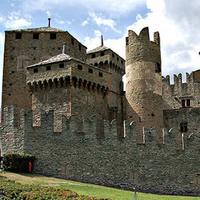5. Chi o cosa erano i cavalieri?
who||thing|||
|||||caballeros
5. Wer oder was waren die Ritter?
5. Who or what were the knights?
5. ¿Quiénes o qué eran los caballeros?
5. Kim lub czym byli rycerze?
5. Quem ou o que eram os cavaleiros?
5. Кем или чем были рыцари?
5. Vem eller vad var riddarna?
Tutti i cavalieri erano uomini, ma solo pochi uomini erano cavalieri.
all||knights|||||few|men||
All knights were men, but only a few men were knights.
Wszyscy rycerze byli mężczyznami, ale tylko kilku mężczyzn było rycerzami.
Bisognava essere di “nascita nobile” e prima allenarsi come paggio e come squire (proprietari di terre).
it was necessary|||birth|noble|||to train||page|||squire|owners||lands
era necesario||||noble|||entrenarse||paje|||escudero|||
You had to be of "noble birth" and first train as a page and as a squire (landowners).
Trzeba było być „szlachetnie urodzonym” i najpierw szkolić się na paźa i dziedzica (właścicieli ziemskich).
Un cavaliere giurava di essere fedele al suo re e alla nazione e alla sua Chiesa.
|knight|he swore||being|faithful|||king|||||||church
||||||||rey|||||||Iglesia
A knight swore to be loyal to his king and the nation and his church.
Rycerz poprzysiągł lojalność swemu królowi, narodowi i kościołowi.
A un cavaliere ci si indirizzava con la parola “Sir”, signore, prima del suo nome.
|to a||||would address|||||||||
A knight was addressed with the word "Sir", sir, before his name.
Per essere facilmente riconosciuto aveva uno stemma sul suo scudo.
||easily|recognized||an|a coat of arms|||shield
||||||escudo|||escudo
To be easily recognized he had a coat of arms on his shield.
In battaglia e nei tornei, i cavalieri indossavano armature.
|battle|||tournaments|||wore|armors
In battle and in tournaments, knights wore armor.
La prima armatura fu fatta di spesso cuoio e anelli di metallo.
||||made||thick|leather||rings||
The first armor was made of thick leather and metal rings.
Più tardi, fu realizzata con pezzi di metallo molto resistenti fissati insieme da giunture.
later|later|it was|realized||pieces||||resistant|fixed|together|by|joints
Later, it was made with very strong pieces of metal fastened together by joints.
Później wykonano go z bardzo mocnych kawałków metalu spiętych łącznikami.
Cosa era uno stemma?
thing|it was||coat of arms
|||escudo
What was a coat of arms?
Un disegno fatto di figure speciali e simboli.
|drawing|made|||special||
A design made up of special figures and symbols.
Ogni famiglia ricca ne aveva uno e si indossava sui vestiti, le armature, sugli scudi così che la gente potesse riconoscerli in battaglia.
||rich||she had||||she wore||clothes|||on|shields|so||||she could|recognize them||
Every rich family had one and it was worn on clothing, armor, shields so that people could recognize them in battle.
Każda bogata rodzina miała jeden i był noszony na odzieży, zbroi, tarczach, aby ludzie mogli je rozpoznać w bitwie.
Quando la gente indossava gli elmetti era difficile dire chi fossero.
|||||helmets|||to say||they were
|||usaba|||||||eran
When people wore helmets it was hard to tell who they were.
Kiedy ludzie nosili hełmy, trudno było powiedzieć, kim są.
Col passare del tempo, l'armatura arrugginiva a contatto con l'acqua, se non la si curava abbastanza.
with|||time|the armor|it rusted||||||not|||she took care of|enough
Over time, the armor rusted in contact with water if not cared for enough.
Z biegiem czasu pancerz rdzewieje w kontakcie z wodą, jeśli nie jest odpowiednio pielęgnowany.
Era il compito dello squire del Cavaliere e dei paggi assicurarsi che non si rovinasse; ogni cosa doveva essere oliata e lucidata.
||task||squire|||||pages|ensure||||it got ruined|||it had to||oiled||polished
||||||||||||||se arruinara|||||aceitada||pulida
It was the duty of the squire of the Knight and of the pages to ensure that it was not ruined; everything had to be oiled and polished.
Obowiązkiem dziedzica Rycerza i stronic było dopilnowanie, aby nie został zrujnowany; wszystko trzeba było naoliwić i wypolerować.

